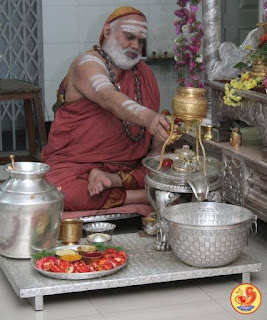SREE KRISHNA TEMPLE, UDUPI
On 02 04 22, we were fortunate to be at Udupi Krishna Temple, as the Ratha was pulled through the four small streets around the temple late evening. We were at Udupi in the evening just before 6 PM and it was arthi time at Chandramouleeswarar temple. First we had darshan at Anantheswara temple, then at Chandramouleeswara and then at Krishna's. As the evening pooja had started at Krishna temple and the Urchava murthy was to be placed in the Ratha, there was a lull in the movement of the Queue for about 30 min and still we had darshan at 7 PM. The ratha yathra started then and our family members had the wonderful experience of drawing the ratha for a few minutes.
Lord Vishnu, in his sixth incarnation as Parashurama, after assaults on Kings who had deviated from the path of Dharma, performed a great yajna. Having donated all the land he won, he was left with no land for Himself. Reluctant to stay in the land already gifted, he reclaimed a strip of land from the Arabian Sea. This coastal strip of land, from Gokarna to Kanyakumari is known as Parashurama Kshetra.
Ramabhoja, a great devotee of Lord Parashurama was proclaimed the King of Parashurama Kshetra. lntending to perform a maha yajna, he got the site for the sacrificial fire ploughed up. A serpent got into the plough and got killed. Although the serpent was a demon in disguise, the king was worried, as it was a sin to kill a serpent. To atone this sin, he was directed by Lord Parasurama to build a big silver pedestal with the image of a serpent at each of its four corners and to worship Him who would be seated in spirit on the pedestal and also to distribute gold equal to his own weight (Tulabhara) to deserving persons. Rambhoja did likewise and performed the Ashwamedha Yajna successfully. At its conclusion, Lord Parasurama appeared and declared that he was pleased with the Yajna and that henceforth the sacrificial land 'Rajatha Peetha' (silver pedestal) would become a famous centre of pilgrimage. This land is also known as 'Thoulava' land because Rambhoja performed 'Tulabhara'.
ANANTHESWARA
Parents of Sree Madhwacharya had prayed here for progeny.
In the Rajatha Peeda, Lord Shiva appeared in the form of Linga and occupied the silver pedestal . It was on the request of Lord Shiva that Lord Parashurama also enshrined within the Linga – the form of Lord Anantha also and hence the name Anantheshwara was given to this unique Linga. The king Ramabhoja also built four Durgalayas(Durga temple) and Nagalayas (Subramanya temple) one each in each direction.
It is also said that Parasuram, an avatar of Vishnu merged with this Linga. However, the idol taken in processions during the festivals is that of Lord Ananthapadmanabha. The temple sanctuary that bears the shape of the back of the elephant (Gajaprashta). It is customary to pray at this temple before proceeding to have darshan at Sree Krishna Temple.
The Udupi Shri Krishna Temple has a rich and illustrious history, aptly reflected in the culture and tradition which has been preserved to date and a must visit destination to experience the Divine grace of the Lord.
Temple Timings: Vishwaroopa Darshan: 05.30 AM to 06.00 AM 06.00 AM to 08.30 PM











































